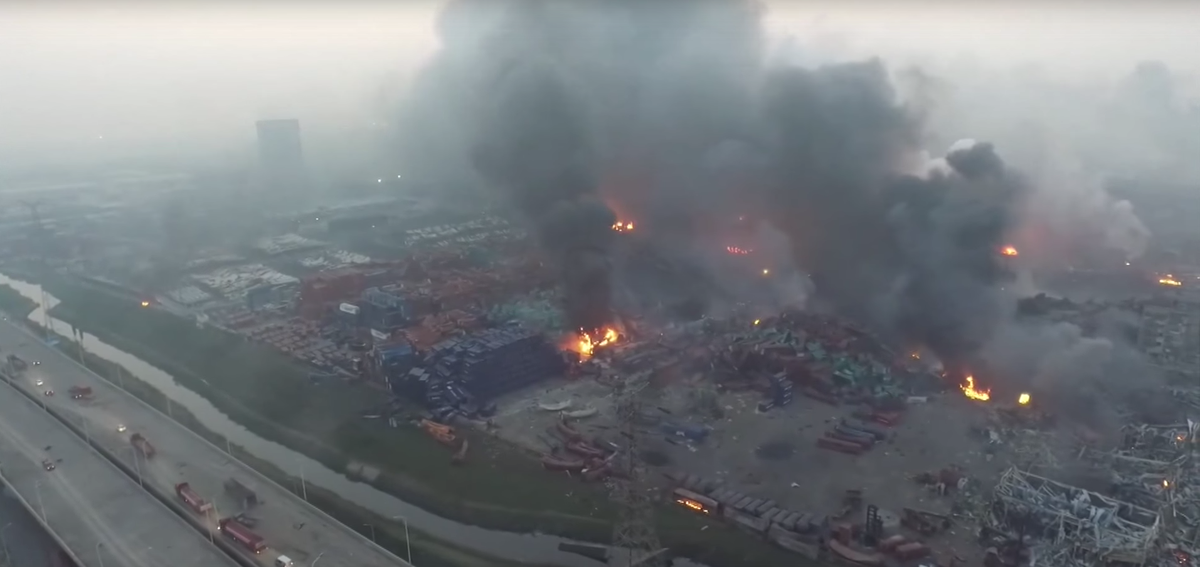
(Photo:BBC)
“Many intermediary organizations are either government-run, semi-government-run, or joint ventures of the government and private sector.
On the 19th August, 2015, the Xinhua News Agency released an interesting report on last week’s Tianjin Ruihai International Logistics storage explosion. While indirectly denying that Li Liang, the nominal chief shareholder of the company, is the nephew of Li Ruihuan, former Standing Committee member of the Politbureau, it confirmed that another chief shareholder, Dong Sheqian, is the son of the former chief of Tianjin Police. It also revealed that the real boss of the company is Yu Xuewei, although his background is still not clear. The reason that the company easily received all the permits necessary for operation despite blatant violation of most rules is because both Dong and Yu colluded with different government departments. The report quotes Dong as saying, “while my connection is chiefly the police and the fire fighting department, Yu has connection with the Production Safety Inspection Bureau, the port management, the customs and the environmental protection bureau.”
Red Hat Agencies
There is yet another player in the game which is neglected in many reports however.
According to the 2001 law on regulating the production and storage of hazardous chemicals, the storage place must be a distance of at least one thousand meters away from residential areas. In the case of the Ruihai storage place the distance was only 600 meters. Yet, according to China Youth Daily, the Safety Evaluation Report prepared for Ruihai, which allowed it to get the government’s permit to operate legally, claims that the storage place’s distance from residential areas is in line with the law. The company which issued this report is called Tianjin Zhongbin Haisheng Safety and Health Evaluation Of Detection Co. Ltd, as was shown in its website (and Zhongbin Haisheng hereafter). According to the 17th August Beijing News, this company is what people may call “hongding zhongjie”, or literally “red hat agencies”. Hongding was the official hat of high ranking Mandarins under the Qing dynasty, and when these Mandarins also opened their own businesses and become businessmen (shangren), they were called hongding shangren. Red hat agencies are just a special kind of red hat company (hongding gongsi), a code word for commercial companies founded by government officials, either as individuals or collectively. Before we go into this further let us first look at the main shareholders of this profit-making private agency Zhongbin Haisheng.
The forerunner of this company was founded in 2003. There are now three main shareholders of this company: the Tianjin Rubber Industry Institute, the Tianjin Dolphin Rubber Group Co. Ltd., and the National Engineering Research Centre for Fire Protection, an institute under the jurisdiction of the Ministry of Public Security and located at the Tianjin Fire Research Institute. All three shareholders are either state owned enterprises or government departments. The last shareholder only became a shareholder in 2008. The joining of forces with the Tianjin Fire Research Institute under the Ministry of Public Security gave Zhongbin Haisheng a huge advantage in winning the class A qualification for “Safety Evaluation Agencies” in 2012. According to the institute's website, it “runs a world-class integrated fire research and testing base”. Obviously its expertise in the field has no bearing on Zhongbin Haisheng’s decision to allow Ruihai to pass the safety evaluation when it did not deserve to.
According to the China Youth Daily report, Ruihai had previously asked another agency to make the safety evaluation report, but the agency’s report did not give its approval to Ruihai. So Ruihai sought help from Zhongbin Haisheng and the latter gave Ruihai a pass, allowing it to get a government permit to operate.
In China it is a common practice for government departments to appoint particular safety evaluation consultants for applicant companies which wish to operate in the storing or manufacturing of dangerous goods. The applicant companies know very well that they can only get licenses for operating by complying with the demand. Very often these consultants are founded or owned by government officials or their cronies, hence the name “red hat agencies”. According to a report, nationally there are now approximately 68 class A and 347 class B safety evaluation agencies.
“Safety evaluations are a game of going through the motions”
The above mentioned Beijing News report dares not directly criticize Zhongbin Haisheng for colluding with Ruihai. Instead it mentions a case which allows us to have a glimpse of how these red hat agencies work and it is therefore worth quoting at length:
“Lots of arguments have been around for some years concerning environmental impact evaluation issues, and how these red hat agencies merely go through the motions when they carry out their evaluations. This problem also exists in the field of safety evaluations. Whereas years ago the laws which governed environmental impact evaluations required openness of information, safety evaluations are still within the category of black-box operations. ”
“In practice, and what is also quite common, the consultants who conduct safety evaluations are appointed by the supervisory departments. Previously, CCTV has reported that in Chongqing, all 42 private gas stations sought the same safety evaluation agency to do their reports. The supervisory department, namely the production safety bureau, claimed that it had just ‘recommended’ the consultant, and did not place any executive order. But since it is this production safety bureau which has the final say on the stations’ safety evaluation, which firms will have the guts to ignore the official ‘recommendation’ and seek an alternative instead?”
“As for safety evaluations, that they are largely a game of going through the motions, is an open secret in the industry. Many companies pay thousands of dollars to get a report to deal with the matter. The safety evaluation of the 42 private gas stations in Chongqing were all done in little more than an hour. The agency staff just walked round the stations for a while and then issued them a safety evaluation report, and charged them 3,000 Yuan.”
Government run PR companies lobbying the government
This comment leads us to a discussion of the zhongjie business, literally “intermediary business”, which is a special type of industry in China. Surely Chinese consultancy and lobbying businesses or the like are nothing special in their own right? What is special in China is that the zhongjie business is someties treated as a single branch of industry, although it includes a wide range of commercial activities, from lobbying, consultancy, intermediary agencies, accounting, auditing, to notary services and authentication and so on. Organizations involved in zhongjie include but are not limited to commercial companies. All kinds of business and trade associations may also fall under this category. If there is anything in common between such a wide ranges of activities, it is the need for the business sector to either lobby the government or to obtain certain official approval or licenses. Here we enter into the realm of what free-market advocates characterize as rent seeking. The Chinese bureaucracy, however, from the very beginning, has never been content merely with bribery. Instead it goes one step further by founding their own zhongjie, or agencies, to exploit the private capitalists in exchange for facilitating the granting of government’s approval or licenses. If one does not do business with these red hat agencies, one will never be able to obtain government approval or permits even if one possesses enough money and qualified technology. This is also why in China the lobbying/consultancy/intermediary/PR services are dominated by government officials or their cronies at every level. For example, China’s first public relations company, China Global Public Relations Company, was founded in 1985 by the Xinhua News Agency. This was achieved with the assistance of the world famous PR company Burson-Marsteller. Since then, bureaucrat-run zhongjie have sprung up everywhere. When businessmen want to bid for government contracts, all they need to do is to seek the help of these government department run agencies to lobby the very same government department.
In 2009, the Academy of Social Sciences published a report Research on Corruption in Social Intermediary Organizations and the Relevant Countermeasures. It points out that:
“In China, commercial bribery, corruption and rent-seeking from government officials, and also intermediary organizations involved in rent-seeking corruption etc, have been intensifying. In various cases of corruption, there are people who make use of audit reports or financial reports or evaluation reports, legally issued by intermediaries like accountants, appraisers, and trade associations etc, to cover up their illegal acts of corruption. This is also the usual practice of rent-seeking government officials. The acts of corruption of these intermediary organizations are mainly grouped into three categories: bribery and assistance with bribery, money laundering, and participation in the misappropriation of state assets, activities which harm the interests of both the shareholders and the consumers. ”
“Many intermediary organizations (such as Trade Promotion Associations, the Chambers of Commerce, trade associations, etc) are themselves founded by people who rely on government connections; they are either government-run, semi-government-run, or joint ventures of the government and private sector. Some intermediary organizations sever their links with their former supervisory departments only in appearance, while in practice they are still linked to the departments. Some intermediary organizations are headed by incumbent government officials, or officials may act as consultants or honorary presidents. Retired officials also may play the same roles as incumbent officials do. This situation creates an entity of shared interest between the government and the agencies.”
It is common to describe the above phenomenon as customary corruption or collusion between officials and the business sector. The problem with the first characterization is that it is far too vague, while the second assumes the separation between government and business. In China’s case government officials are also businessmen. They combine both the coercive power of the state apparatus and the power of money to become rich and powerful at the same time. In the 1930s the CCP criticized the KMT for being the chief representative of the bureaucratic bourgeoisie. Today this accusation is a thousand times more applicable to the CCP.
The Beijing News comments that the Ruihai safety assessment evaluation issue “should be thoroughly investigated ..., and that these red hat agencies must be smashed, the interest chain behind the scene should be cut off.” One can hardly disagree with this, but the problem is by whom should it be investigated? The CCP, since thirty years ago, has been going through the motions of reiterating the ban on government departments and officials founding commercial companies. The result is that the bureaucracy comes up with even more business activities. If the CCP is still capable of self-reform, there would not have been a Tianjin blast in the first place, or any similar disasters.
The CCP is so armed to the teeth and remains so powerful that no forces are yet able to challenge it from the outside. The problem, however, is that the CCP is the biggest enemy of itself. Physics tells us that when a large star is old enough, its core can no longer bear its own weight. Its outer region therefore explodes, followed by its inner core collapsing and imploding and then turning into a black hole. Today’s CCP has grown to such a monstrous size and power that its rotten core is also increasingly unable to bear the weight of itself. The Tianjin blast is just one of its outer region explosions before it implodes.
August 20, 2015
